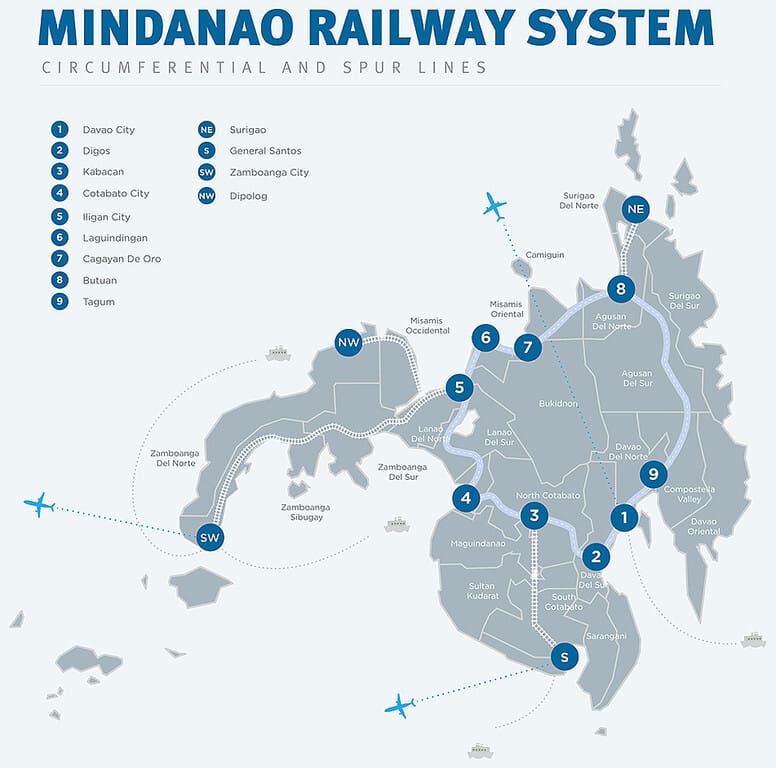- Future Southeast Asia
- Posts
- Could the Philippines build a Pan-Philippine High-Speed Railway?
Could the Philippines build a Pan-Philippine High-Speed Railway?
Is it possible to build a high-speed railway from Manila to Davao, and should the Philippines build such a railway?
The Philippines is drafting a 30-year railway master plan, which includes rebuilding the railway in Luzon and building a new railway in Mindanao. There have been some mentions of upgrading the proposed railways in Luzon and Mindanao to high-speed, but there is no official plan.
National Unity Party president and Camarines Sur Rep. L Ray Villafuerte mentioned that Vietnam is planning a high-speed train system, and that the Philippines should also be considering a HSR.
If Vietnam start building the high-speed railway in 2026 as planned, then there might be some HSR FOMO across the region, including the Philippines.
An article in the Philippine Daily Inquirer mentioned that a bullet train from Manila to Davao is technically possible, using Japan as an example of connecting multiple islands.
If you are unfamiliar with the geography of the Philippines, building a railway across an archipelago of over 7,000 islands sounds like a crazy plan. However, a north-south railway would only need to travel on four islands with three bridges.

Could (and should) the Philippines build a Pan-Philippine high-speed railway? This article covers whether it’s technically possible to build a high-speed railway from Luzon to Mindanao.
Luzon
The island of Luzon would be the most logical place to build a high-speed railway in the Philippines. San Miguel Corp (SMC) proposed a high-speed railway from the north to the south end of Luzon in 2010, but this project didn’t eventuate.
A true North-South Luzon HSR would be unlikely now that the construction of the North-South Commuter Railway is underway.
The NSCR Railway (also known as the Clark–Calamba Railway) is a 147 km commuter railway that will run through the Greater Manila Area. The commuter railway will have a top speed of 120 km/h, while the airport express will have a top speed of 160 km/h.

NSCR Map (via SMEC).
The NSCR is not built to be a high-speed railway, and it would be impossible to blaze a new corridor through Greater Manila for another line.
If a Luzon high-speed railway were to be built, it would have to start at Clark for North Luzon and Calamba for South Luzon.
A North Luzon Railway has been proposed (known as the Amianan Express), and it will have an operating speed of 180 km/h. This falls short of the minimum definition of high-speed of 200 km/h, and is not near 250 km/h, which is considered high-speed by most countries.
For South Luzon, the reconstruction of the PNR South Long Haul (PNR Bicol) from Calamba to Albay will be 565 km in length with a top speed of 160 km/h. This project has stalled, so there is still technically a chance that it could be upgraded to a high-speed railway before committing to the current semi-high-speed plan.
Luzon-Samar Bridge
One of the two missing links to connect the three main island groups of Luzon, Visayas, and Mindanao is a bridge from Luzon to Samar.
The proposed Luzon-Samar Bridge is estimated to be 18.2 km in length, which is long, but it wouldn’t be the longest bridge in Southeast Asia.
If the Philippines were to build a Pan-Philippine Railway (high-speed or otherwise), then it could include a railway section on this bridge. A good example of a long bridge with a railway is the Øresund Bridge between Denmark and Sweden.

Øresund Bridge
The Øresund Line runs on the lower level of the bridge, and the roadway is on the upper level.

Cross-section of the Øresund Bridge.
The bridge section of the Øresund Bridge is “only” 7.85 km, so it would be a greater challenge to build an 18 km bridge with a railway deck.
Samar and Leyte
Bridge or no bridge, the next section of railway would traverse through the islands of Samar and Leyte in the Visayas region.
There is already a proposal for a railway between Samar and Leyte as part of the Eastern Visayas Metro Rail System.
The two islands are currently connected by road via the San Juanico Bridge (2,164 m), which is a relatively short crossing compared to Luzon-Samar. A new rail bridge would need to be built to complete the Eastern Visayas railway system.
Leyte-Mindanao Bridge
The proposed Leyte-Mindanao Bridge is the second missing link of the Pan-Philippine Highway, though this bridge proposal is currently sitting in the “Too Hard” basket.
The bridge would be 23 km in length, but it would cross deep water with strong currents. An alternative bridge would run via the Dinagat Islands with a series of bridges and roadways. Either plans are unlikely to be built.
Mindanao
The Mindanao Railway is an ambitious 2,000 km railway that would connect the major cities of the island. When Duterte (a Mindanaoan) became president in 2016, it looked like this project would become a reality, but not a single kilometre of railway is operational.

The railway will go the the ferry port in Surigao City, so it can connect with the ferry to Leyte.
Is a Pan-Philippine High-Speed Railway possible?
Considering the current railway projects and the technical difficulties of the missing-link bridges, a true Pan-Philippine high-speed railway is not going to happen.
The best-case scenario would be for semi-high-speed railways (160 km/h) on pan-island railways on Luzon, Samar, Leyte, and Mindanao. These railways would be a massive improvement on intra-island travel, and a North-South Railway with two ferry trips would be a great boost for tourism.
Reply